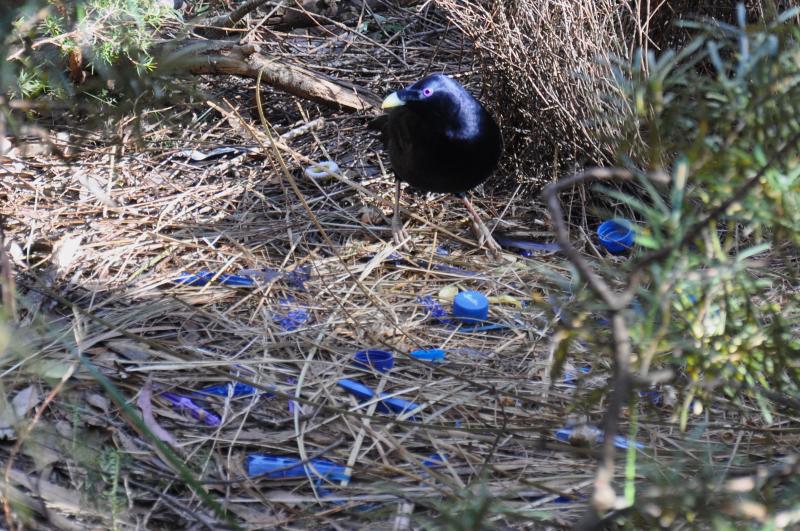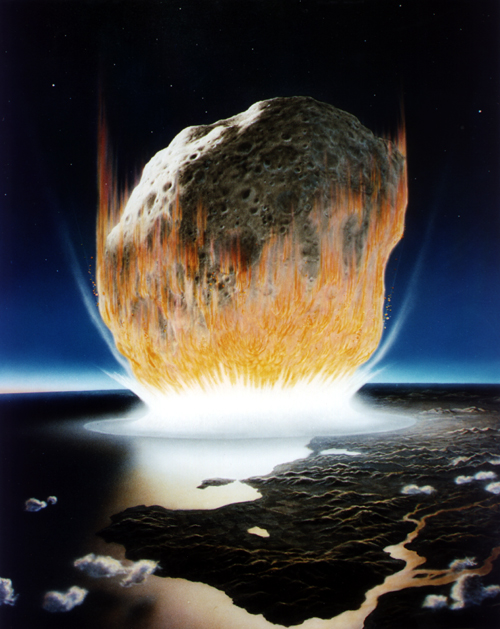Last week, we started talking about a common misconception:
Misconception: Evolution is random.
For which I earlier offered a correction:
Correction: Evolution is neither entirely random nor entirely non-random.
Mutations, I explained, are random in the sense that the effect of a mutation on the organism—good, bad, or neutral—is not correlated to the environment. (It might have been nice for humans to have  developed longer fingers when pianos were invented, but we have to play [with] the hands we’re dealt. As it were.) But natural selection is anything but random: it takes the raw material of mutation and sculpts it into the marvelous adaptations that so impress us, from parasitic worms that zombify their cricket hosts to ants that cultivate fungi farms to birds that build elaborately decorated nests to woo the ladies. And of course, there are these guys.
developed longer fingers when pianos were invented, but we have to play [with] the hands we’re dealt. As it were.) But natural selection is anything but random: it takes the raw material of mutation and sculpts it into the marvelous adaptations that so impress us, from parasitic worms that zombify their cricket hosts to ants that cultivate fungi farms to birds that build elaborately decorated nests to woo the ladies. And of course, there are these guys.
But natural selection is not intractable. It can be bumped and nudged and thrown off course by new mutations and also, significantly, by changes in the environment. A variation that is helpful today may not be helpful tomorrow. To illustrate this, think back to our old friends the peppered moths. First, light-colored morphs were favored over dark-colored morphs. Once the soot settled on the trees on which they perched, dark-colored moths held the advantage. Then, once the pollution was abated, light-colored morphs were once again favored over dark-colored morphs. (It’s a bit like the Sneetches, only with less political allegory and more being eaten by birds.)
Another great example of the environment throwing a curve ball happened 65,000,025 years ago when a giant asteroid struck Earth. (How can I be so exact? Well, when I learned about it twenty-five years ago, they said that it happened 65 million years ago, so…) If you’ve studied it, you probably learned that this catastrophic event wiped  Earth’s slate pretty clean, opening up niches and ushering in the so-called Age of Mammals. (As an aside, I hate all of the “Age of” categorizations oh-so-common in textbooks and media. It was and always will be “the Age of Bacteria,” okay?) This description of how things unfolded makes a lot of sense in hindsight. Mammals of the late Mesozoic were small, omnivorous, burrowing, and probably nocturnal creatures. A long period of dark, cold, barrenness would have been survivable. But try this thought experiment: Imagine that you’re visiting the late Cretaceous, just one day, heck, one minute before impact. Look around. Would you have guessed that this creature would succeed over this creature? No way. And the reason why you couldn’t have guessed it is because the incredible evolutionary leap that occurred 65 million years ago was the product of a total fluke. The environment suddenly changed with no warning—it was a random event.
Earth’s slate pretty clean, opening up niches and ushering in the so-called Age of Mammals. (As an aside, I hate all of the “Age of” categorizations oh-so-common in textbooks and media. It was and always will be “the Age of Bacteria,” okay?) This description of how things unfolded makes a lot of sense in hindsight. Mammals of the late Mesozoic were small, omnivorous, burrowing, and probably nocturnal creatures. A long period of dark, cold, barrenness would have been survivable. But try this thought experiment: Imagine that you’re visiting the late Cretaceous, just one day, heck, one minute before impact. Look around. Would you have guessed that this creature would succeed over this creature? No way. And the reason why you couldn’t have guessed it is because the incredible evolutionary leap that occurred 65 million years ago was the product of a total fluke. The environment suddenly changed with no warning—it was a random event.
So evolution is not entirely random, but it is not entirely non-random either. In the classroom, it’s important to emphasize this point as often as you can and to provide opportunities for your students to demonstrate their understanding. From the earliest grades on up, be careful in your presentations not to provide a characterization of evolution that is too stochastic or too deterministic. At the youngest grades, use the ever-popular dinosaur extinction to illustrate how unexpected events have affected life on Earth. Give students a scenario akin to the peppered moth example and ask them to make predictions about how simple trait distributions will shift when the environment changes.
In high school, you could present some of the classic experiments that demonstrated the randomness of mutation, such as the 1952 Lederberg experiments, which showed that antibiotic resistance in bacteria wasn’t caused by their exposure to the antibiotic. Additionally, there are some excellent activities, such as Karin Westerling’s origami bird activity, that simulate random mutation and subsequent selection. These provide a great opportunity to be super explicit about which parts of the evolutionary process are random, and which parts are not. And, of course, you should remind high school students that natural selection is just one mechanism of evolution. Remember genetic drift? Guess what? It's random! So lest your students get too comfortable with non-random selection, throw them a genetic drift curveball once in a while! And finally, as communication skills are being emphasized more and more, ask students to write a persuasive essay or make an informational video that debunk the claims that evolution is random and evolution is predetermined.
Things are simpler in black and white. It’d be easier if evolution were entirely random or entirely deterministic. But it’s just not. I’m okay with it, though—after all, if it were entirely one or the other, this blog would be a lot less interesting.
--
Have an idea for a future Misconception Monday or any other kind of post? See some good or bad examples of science communication lately? Drop me an email or shoot me a tweet <at>keeps3.

